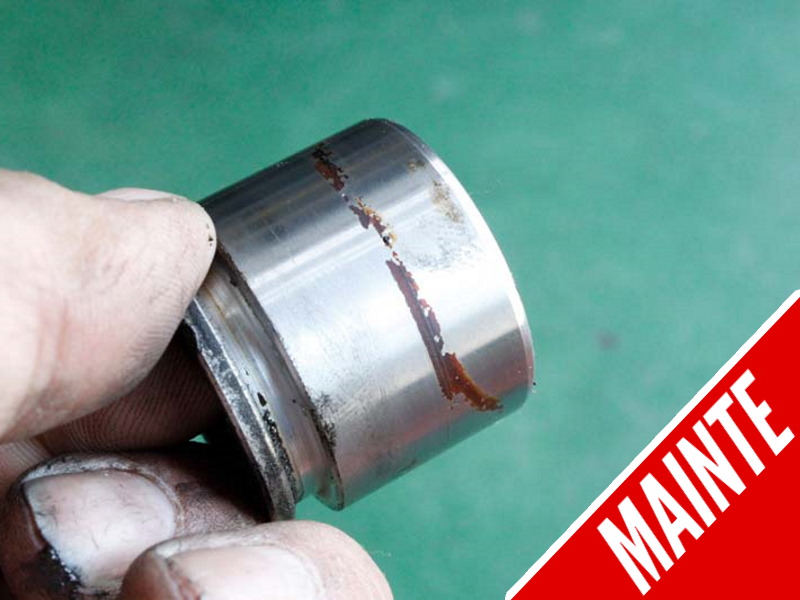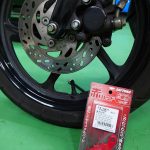It is a well-known fact that if a vehicle is left unattended and maintenance is neglected, or if the vehicle is parked neglectfully, the brake fluid will deteriorate due to moisture absorption and damage the brake-related parts, regardless of whether it is an older or younger model. When practicing overhaul and overhaul maintenance of brake parts, keep refreshing in mind to make the parts more beautiful.
- If I can buy new parts, I want to replace or secure them.
- To remove the master cylinder, use a special tool!!
- Caliper pistons polished & checked
- Piston seal groove cleaned
- Baked paint with a gun coat
- A small tabletop high-temperature dryer.
- SWAGE-LINE brake hose.
- After air bleeding is complete, lock the brake lever!
If I can buy new parts, I want to replace or secure them.


The main brake parts include the brake master cylinder, brake caliper and caliper bracket, and in the case of double disc models, the junction in the middle of the brake hose. Glycol-based brake fluids such as DOT3 and DOT4 are hygroscopic, a characteristic that often causes damage to brake-related parts. Moisture causes rusting and corrosion of major aluminum parts. When practicing disassembly maintenance of brake parts, the ironclad rule is to disassemble the parts down to the individual component level. The rubber parts and various seals that need to be replaced should be replaced with new parts. If the aluminum parts are corroded, the anti-corrosion paint will peel off, so if the parts are completely disassembled, it is a good idea to repaint them at this time.
To remove the master cylinder, use a special tool!!


There is a trick to removing the master piston and cup seal from the brake master cylinder. Use a screwdriver or stick to push in the piston end where the brake lever pushes in to release the force on the snap ring (circlip), and then use the L-shaped snap ring pliers for easy disassembly. When assembling and restoring the piston, use the L-shaped pliers for the hole to shrink the snap ring and push the piston back into place. I thought it would be a good idea to use the side of the U-shaped thin-walled pipe to push in the force of the piston being returned by the spring. Since there is no such tool on the market, I think it would be useful to have a special tool for the master piston size. If such a tool is sold, I think it would definitely enhance the workability.
Caliper pistons polished & checked


A torn dust seal or dust boot can allow rainwater to penetrate the sliding surface of the brake piston seal, causing the outer circumference of the piston to become worm-eaten with spot rust. Such pistons need to be replaced. Even if it is not worm-eaten, there are many cases where the surface is lightly rusted, so use fine steel wool (Bonstar) to remove dirt and rust.
Piston seal groove cleaned

The square cross-section brake caliper piston seal plays a major role in shutting off the piston function from outside air and rainwater. There is a groove in the caliper body that holds the piston seal, and you can use a cleaning tool to scrape off the chalky residue that has accumulated in the groove. If you use a tool with too sharp a tip, it will damage the seal groove, so use a tool with a non-sharp tip and scrape the dirt off as you slide it around. All the black aluminum parts will be repainted for a beautiful finish.
Baked paint with a gun coat


Guncoat paint boasts an overwhelmingly high level of weather resistance to gasoline as well as brake fluid, various solvents, and chemicals by drying completely after painting. Here, I used Satin Black, a semi-gloss black paint. Before painting, the corroded parts were sandblasted to completely remove dirt and corrosion from the old paint, then dried in a high-temperature dryer before painting. The key to a beautiful finish is to apply several thin, even layers of paint.
Interviewed in cooperation with Carvek https://www.carvek.jp/
A small tabletop high-temperature dryer.


CARVEK, the domestic importer and distributor of gun coat paints manufactured by KG, is developing and selling a low-cost, compact tabletop high temperature dryer to promote the use of gun coat paints. This is the CV-JUNIOR made by Carvek. Guncoat paint is a one-component paint that is easy to apply with a high yield. I always let it bake dry for an hour and a half to 2 hours, but its weather resistance to brake fluid is extremely high.
SWAGE-LINE brake hose.


The brake hoses incorporated high-performance SWAGE-LINE with chic black coating to prevent expansion. The banjo fittings were temporarily assembled to the brake calipers and master cylinder, and the routing of the brake lines was determined with the front wheel lifted and the front forks extended. A rather thick piece of aluminum wire or aluminum welding rod is useful to visualize the routing.
After air bleeding is complete, lock the brake lever!

After installing the brake lines, pouring in the brake fluid, and removing any trapped air, the finishing touch is to hold the brake lever locked. If you lean the vehicle on the side stand with the steering wheel turned all the way to the left and hold the brake lever overnight, the air release situation will be even better. After the work, the brake lever will be flat and the direct feeling will be stronger. I used a circle of old tubing to squeeze and maintain the lever.
- Point 1: Stock up on repair parts for your motorcycle before the OEM parts run out.
- Point 2: When painting, understand the characteristics of the paint material before using it.
- Point 3: When purchasing a general-purpose brake hose, a wire is an easy way to check the length.
At what age is the line between older and younger motorcycles?!? It depends on the feelings of the individual motorcycle enthusiast, but regardless of the year of the motorcycle, if it is not maintained in good condition, it will not be possible to ride comfortably. Of all the parts, the brake parts are the ones that determine the quality of braking power, so regardless of the age of the motorcycle, it is the brake parts that should always be in good condition.
For example, even if there is enough braking power to bring the motorcycle to a screeching halt when you grip the brake lever to check the braking force, the lever feeling may not give you the best impression. Specifically, the impression may be influenced not by the braking performance but by the operation of the brake lever. If the lever pivot is not tightened properly, there may be a lot of rattle, or the lever may be reluctant to move.
Also, if the part of the brake lever that pushes the brake master piston is in poor condition, worn or has a lot of sliding resistance, the master piston will not follow the lever-action very well, and even if you do not notice it when you squeeze the lever hard, such as during emergency braking, the brake pads and shoes will be pulled and rubbed. When you want to control the brake pads or shoes by rubbing them, you may not notice it, but when you want to control the brake pads or shoes, you may feel strange and uncomfortable.
When it comes to brake calipers, if the caliper does not work well in the control area, it gives a strong impression that it does not work well. The caliper pistons are greatly affected by the condition of the area around the caliper seal, so if you don't take care to maintain the condition of the area around the piston seal, not only will the brakes not work well, but the brake pads will rub against each other when you push and walk, causing the brake pads to emit an annoying "squeak" sound as you move.
Have you ever heard of the term "lean out cleaning" for brake pistons? For example, when you go shopping at a major parts store, you will hear an announcement in the store saying, "How is the condition of your brake caliper?" At this time, the service department will be able to provide you with a "rubbing out maintenance" without any waiting time. The work included removing the brake pads, keeping the caliper pistons pushed out, and cleaning the area around the pistons.
In addition, metal rubber and other chemicals are sprayed on and polished up. This is a maintenance technique that can greatly improve the touch of the brake lever without replacing any parts.
The brake master and brake calipers, which were clearly not beautiful (dirty) and the factory paint was peeling off, were completely disassembled and cleaned up. The brake master and calipers were completely disassembled and cleaned up, and then gun coat paint, which is resistant to brake fluid, solvents, and chemicals, was applied for a beautiful finish. The condition of the brakes will change in proportion to proper maintenance, so if you are concerned about the condition of your brakes, don't put it off.



